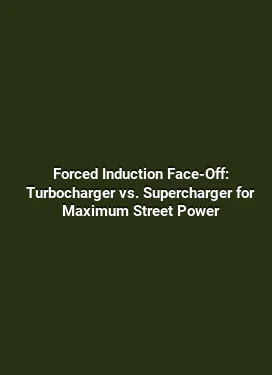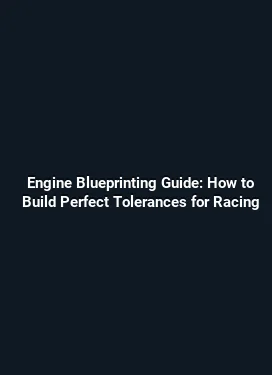How to Tune VVT-i System on Toyota 2JZ-GTE for Maximum Power
VVT-i Tuning Fundamentals for the 2JZ-GTE

The Toyota 2JZ-GTE is renowned for its robust architecture and the potential to extract significant power through precise management of variable valve timing. The VVT-i system adjusts the intake cam phase to optimize cylinder filling across the engine’s operating range. When tuning, the goal is to harmonize cam phasing with turbocharger behavior, fuel delivery, ignition timing, and airflow characteristics to achieve a broader and more efficient powerband. The tuning approach should emphasize repeatable gains, drivability, and reliability under sustained operation, rather than chasing peak numbers alone.
At the core, VVT-i tuning involves controlling the oil-pressure-driven variable cam phasers that alter the intake cam timing. The main objectives are to advance intake timing at low and mid RPM for improved cylinder fill, and to retard or maintain timing at higher RPMs to prevent detonation and to align with turbo dynamics. The result is a more linear torque curve, quicker boost response, and improved breathing through the entire RPM range. Practically, this requires a holistic view of the engine management strategy, including boost control, fueling strategies, and ignition maps, to ensure the altered cam timing translates into real, repeatable horsepower gains rather than transient peaks that degrade under load.
Understanding the VVT-i System and Its Impact on Power

The VVT-i system uses a solenoid-driven oil control mechanism to adjust the camshaft position. When the system advances the intake cam, the opening and closing events occur earlier, allowing more air to enter the cylinder during the intake stroke. This enhances low-to-mid range torque and throttle response. Conversely, delaying the cam at higher RPMs helps mitigate reversion and detonation risks associated with high boost and aggressive ignition timing. The interplay between the VVT-i timing, turbocharger boost onset, and fuel delivery is crucial for achieving a cohesive power increase rather than isolated improvements at specific RPM bands.
From a practical standpoint, tuning should consider valve train reliability (milage, wear, and oil quality), oil pressure stability, and the dynamics of the engine’s intake tract. A well-tuned VVT-i system reduces valve overlap penalties, improves volumetric efficiency, and can contribute to a more favorable air-fuel ratio during high-boost operation. Understanding the baseline VVT-i behavior on stock maps is essential; it provides a reference for identifying where gains can be made without compromising engine health. In summary, VVT-i tuning is not a standalone modification but a key component of a cohesive engine-management strategy that includes fuel, ignition, and boost control.
Assessment: Baseline Data and Diagnostic Tools
Before any tuning work begins, establish a solid baseline. This means collecting data across multiple operating conditions: idle, part-throttle cruise, and near-peak boost scenarios. Modern engine-management systems monitor cam-phasing behavior, boost pressure, oxygen sensor feedback, knock sensors, and fuel trims. Document the stock cam-advance trajectory and how it shifts with RPM and load. A data-driven approach prevents over-tuning and helps identify which ranges benefit most from VVT-i adjustments.
Key diagnostic steps include inspecting oil pressure stability, solenoid response times, and the integrity of the camshaft phasers. Worn solenoids or degraded oil passages can masquerade as tuning problems, leading to misinterpretation of the potential gains. A clean, indexed oil system and correctly torqued valve-cover hardware ensure the VVT-i mechanism operates within intended tolerances. In practice, vehicle dynamics logging, coupled with chassis dynamometer runs, provides the framework for comparing stock versus tuned behavior under repeatable conditions.
Testing Protocols for Power and Driveability
A structured test plan should cover three core phases: baseline testing, transition testing, and durability verification. Baseline testing confirms current behavior. Transition testing evaluates the impact of incremental cam-timing adjustments on power, torque, and throttle response. Durability testing examines how the engine behaves under sustained high-load scenarios, such as repeated full-throttle accelerations or prolonged highway cruising with elevated boost. Use multiple data points to map out the relationship between VVT-i timing, boost onset, and ignition timing. This reduces the risk of creating an over-advanced or over-retarded cam profile that might look favorable in narrow tests but perform poorly under real-world conditions.
Practical Tuning Strategies for Maximum Power
Adopting a practical, repeatable tuning strategy is essential. The objective is to improve top-end power without sacrificing drivability and engine longevity. A structured approach combines cam timing optimization with fuel and ignition calibration, ensuring that air charge, fuel delivery, and combustion timing align with the new valve events. The following strategies are commonly employed by enthusiasts and professional tuners for the 2JZ-GTE platform.
Incremental Cam Timing Shifts and their Effects
Begin with conservative cam-timing adjustments that advance intake timing by small increments at lower RPM ranges. This improves throttle response and mid-range torque. Gradually extend adjustments to higher RPMs to exploit the increased boost capability of the turbocharger, while carefully monitoring knock resistance and ignition margins. The aim is to extend the usable RPM range where the engine breathes efficiently, rather than pursuing a single peak horsepower number. Real-world gains often appear as a spread in the torque curve rather than an isolated spike in horsepower.
Synchronizing Boost Control with VVT-i
Boost control strategies must be aligned with the cam timing scheme. When intake timing is advanced, the engine tends to spool the turbo earlier and can generate peak boost sooner. This requires recalibrating the wastegate duty cycle and the turbo’s compressor map to maintain steady, predictable boost pressure. A well-coordinated map reduces the risk of boost creep or surge during rapid throttle changes, which in turn stabilizes the air-fuel mixture and ignition timing. The integrated approach yields smoother power delivery and more linear acceleration, even under dynamic driving conditions.
Fueling and Ignition Considerations
With cam timing modifications, fueling strategies should be revisited to ensure the air-fuel ratio remains within safe, high-performance ranges across the entire RPM spectrum. In practice, this means adjusting injector pulse widths, rail pressure (where applicable), and target lambda values to accommodate the altered volumetric efficiency. Spark timing should be retuned to preserve knock resistance, factoring in improved air charge and potential changes in cylinder pressure due to advanced timing. A conservative approach involves validating the engine’s knock resistance on a controlled dyno surface before street testing beyond safe thresholds.
Durability and Reliability Considerations
Power gains are meaningful only if they can be maintained over time without compromising reliability. The VVT-i system relies on precise oil supply and clean passages; contaminants or oil degradation can lead to erratic phasing and degraded performance. Regular oil changes with high-quality, viscosity-appropriate oil are essential. It is also prudent to verify the health of the cam phasers and solenoids, especially on higher-mileage builds. Consistent maintenance of the oil pump, oil filter, and supply lines ensures stable phasing under high-load conditions. The best tuning results come from a balanced combination of performance, reliability, and predictable operation across temperatures and driving styles.
Seasonal and Temperature Effects
Ambient temperature and coolant temperature influence engine breathing and timing behavior. Colder air increases density, which can accentuate the benefits of advanced cam timing, while hot conditions may require more conservative timing to avoid knock. Tuning should incorporate adaptive adjustments or lightweight compensation strategies to maintain consistent results across seasonal changes. In practice, this means testing across varied climate conditions and implementing robust airmass and temperature compensation in the mapping strategy.
Scenario-Based Tuning Examples
Consider a scenario where a stock 2JZ-GTE produces peak power at high boost with moderate throttle response. By carefully advancing intake timing in mid-RPM ranges and aligning boost onset with the revised cam events, the engine may exhibit improved mid-range torque and a smoother spool. A second scenario might involve a higher-boost, single-turbo configuration where you adopt a conservative approach to cam timing to preserve knock margins while allowing the turbo to sustain higher boost without triggering detonation. Each scenario should be validated on a dynamometer with traceable data and multiple drive cycles to confirm gains without unwanted side effects.
Documentation, Record-Keeping, and Safety
Maintaining a detailed tuning log is essential. Record the baseline maps, the exact cam-timing adjustments, fuel calibrations, ignition margins, and boost targets. Note environmental conditions, fuel grade, and any observed anomalies during testing. This documentation not only aids reproducibility but also helps in iterative refinements. Safety measures include ensuring proper engine cooling under load, secure fasteners for the valve covers, and verifying sensor connections after each tuning iteration. A disciplined approach minimizes risk while maximizing the return from the VVT-i tuning effort.
Real-World Scenarios: Street, Track, and Daily Driving
In street scenarios, the emphasis is on consistent power delivery and good throttle response. A tuned VVT-i setup should feel linear, with minimal throttle hesitation and a broad powerband that remains usable across typical driving situations. For track usage, stability and predictability under quick shifts and high-G cornering become critical. The tuning should emphasize resilience to heat soak and sustained high RPM operation. For daily driving, drivability, fuel economy (relative to performance goals), and smooth transitions between off-boost and boosted states are key considerations. Each application benefits from a tailored map that respects the unique characteristics of the vehicle’s build and the owner’s goals.
Listening to the Engine: Feedback and Fine-Tuning
Finally, tuning is an evolving process. Use a combination of data logs, on-dash feedback, and feel-based assessments to refine cam timing and supporting maps. Subtle changes can have meaningful effects on torque delivery and fuel efficiency. It is not uncommon to revisit the calibration after road testing to confirm that improvements persist outside the dyno environment. Through iterative adjustments, the VVT-i system becomes a reliable ally in achieving a more powerful, responsive, and durable 2JZ-GTE setup.






